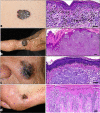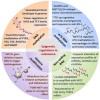Signal pathways of melanoma and targeted therapy
- PMID: 34924562
- PMCID: PMC8685279
- DOI: 10.1038/s41392-021-00827-6
Signal pathways of melanoma and targeted therapy
Abstract
Melanoma is the most lethal skin cancer that originates from the malignant transformation of melanocytes. Although melanoma has long been regarded as a cancerous malignancy with few therapeutic options, increased biological understanding and unprecedented innovations in therapies targeting mutated driver genes and immune checkpoints have substantially improved the prognosis of patients. However, the low response rate and inevitable occurrence of resistance to currently available targeted therapies have posed the obstacle in the path of melanoma management to obtain further amelioration. Therefore, it is necessary to understand the mechanisms underlying melanoma pathogenesis more comprehensively, which might lead to more substantial progress in therapeutic approaches and expand clinical options for melanoma therapy. In this review, we firstly make a brief introduction to melanoma epidemiology, clinical subtypes, risk factors, and current therapies. Then, the signal pathways orchestrating melanoma pathogenesis, including genetic mutations, key transcriptional regulators, epigenetic dysregulations, metabolic reprogramming, crucial metastasis-related signals, tumor-promoting inflammatory pathways, and pro-angiogenic factors, have been systemically reviewed and discussed. Subsequently, we outline current progresses in therapies targeting mutated driver genes and immune checkpoints, as well as the mechanisms underlying the treatment resistance. Finally, the prospects and challenges in the development of melanoma therapy, especially immunotherapy and related ongoing clinical trials, are summarized and discussed.
© 2021. The Author(s).
Conflict of interest statement
The authors declare no competing interests.
Figures






References
-
- Schadendorf D, et al. Melanoma. Lancet. 2018;392:971–984. - PubMed
-
- Liu L, Zhang W, Gao T, Li C. Is UV an etiological factor of acral melanoma? J. Expo. Sci. Environ. Epidemiol. 2016;26:539–545. - PubMed
-
- Siegel RL, Miller KD, Fuchs HE, Jemal A. Cancer statistics, 2021. CA Cancer J. Clin. 2021;71:7–33. - PubMed
-
- Schadendorf D, et al. Melanoma. Nat. Rev. Dis. Prim. 2015;1:15003. - PubMed
Publication types
MeSH terms
LinkOut - more resources
Full Text Sources
Other Literature Sources
Medical

